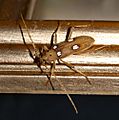Longhorn beetle facts for kids
Quick facts for kids Cerambycidae |
|
|---|---|
 |
|
| Necydalis mellita | |
| Scientific classification | |
| Kingdom: | |
| Phylum: | |
| Class: | |
| Order: | |
| Suborder: | |
| Superfamily: |
Chrysomeloidea
|
| Family: |
Cerambycidae
Latreille, 1802
|
| Subfamilies | |
|
Cerambycinae |
|
The longhorn beetles (scientific name: Cerambycidae) are a fascinating group of beetles. They are famous for their super long antennae, which can sometimes be even longer than their whole body! There are thousands of different kinds of longhorn beetles found all over the world. These beetles play important roles in nature, especially in forests.
| Top - 0-9 A B C D E F G H I J K L M N O P Q R S T U V W X Y Z |
What are Longhorn Beetles?
Longhorn beetles belong to the family Cerambycidae. This name comes from a Greek word meaning "horned beetle." They are part of the larger group of insects called Coleoptera, which includes all beetles. What makes them special are their very long antennae.
Amazing Antennae
The antennae of longhorn beetles are truly amazing. They can be thin and whip-like or thick and segmented. These antennae are not just for show. Beetles use them to feel their way around. They also use them to smell food, find mates, and even detect danger. Some species have antennae that are two or three times longer than their body!
Where They Live
Longhorn beetles live in many different places. You can find them in forests, woodlands, and even gardens. They are common in tropical areas but also live in colder regions. Many species prefer to live near trees. This is because their larvae, or young, often live inside wood.
Life Cycle of a Longhorn Beetle
Like all beetles, longhorn beetles go through a complete metamorphosis. This means they change completely during their life. Their life cycle has four main stages: egg, larva, pupa, and adult.
Egg Stage
Adult female longhorn beetles lay their tiny eggs. They usually place them in cracks in tree bark. Sometimes they lay eggs on dead wood or even on living plants. The eggs are very small and hard to see.
Larva Stage
Once the eggs hatch, tiny larvae emerge. These larvae are often called "roundheaded borers." They are usually white or yellowish and have strong jaws. The larvae spend most of their lives inside wood. They tunnel through the wood, eating it as they go. This stage can last from a few months to several years. It depends on the species and the environment.
Pupa Stage
After growing enough, the larva changes into a pupa. The pupa stage is a resting period. During this time, the beetle transforms from a worm-like larva into an adult beetle. The pupa usually stays inside the wood.
Adult Stage
Finally, the adult longhorn beetle emerges from the wood. Adults usually live for only a few weeks or months. Their main job is to find a mate and lay eggs. Some adults feed on pollen, nectar, or tree sap. Others do not eat at all. They just focus on reproduction.
What Do They Eat?
The diet of longhorn beetles changes during their life.
Larval Diet
Most longhorn beetle larvae are herbivores. This means they eat plants. They especially love wood. They tunnel through the wood of trees, both living and dead. Some larvae prefer specific types of trees. For example, some only eat oak, while others prefer pine. Their feeding habits can sometimes harm trees.
Adult Diet
Adult longhorn beetles have different diets. Many adults feed on pollen and nectar from flowers. This makes them important pollinators. Other adults might feed on tree sap or decaying fruit. Some species do not eat at all as adults. They live off the energy stored from their larval stage.
Importance in Nature
Longhorn beetles play several important roles in their ecosystems.
Decomposers
Many longhorn beetle larvae help break down dead wood. By tunneling through logs and fallen trees, they help speed up the decomposition process. This returns nutrients to the soil. This is very important for healthy forests.
Pollinators
Some adult longhorn beetles visit flowers to feed on pollen and nectar. As they move from flower to flower, they carry pollen. This helps plants reproduce. They are not as famous as bees, but they still contribute to pollination.
Food Source
Longhorn beetles, both larvae and adults, are a food source for other animals. Birds, small mammals, and other insects often prey on them. This makes them a part of the food web.
Types of Longhorn Beetles
There are over 35,000 known species of longhorn beetles worldwide. Here are a few examples:
- Cactus longhorn beetle: This beetle lives in deserts and feeds on cactus plants.
- Citrus long-horned beetle: This species is known for damaging citrus trees.
- Asian long-horned beetle: This beetle is a serious pest that can harm many types of hardwood trees.
- Milkweed beetle: This beetle is often found on milkweed plants.
- Valley elderberry longhorn beetle: This beetle is an endangered species found in California.
Images for kids
See also
 In Spanish: Cerambícidos para niños
In Spanish: Cerambícidos para niños






